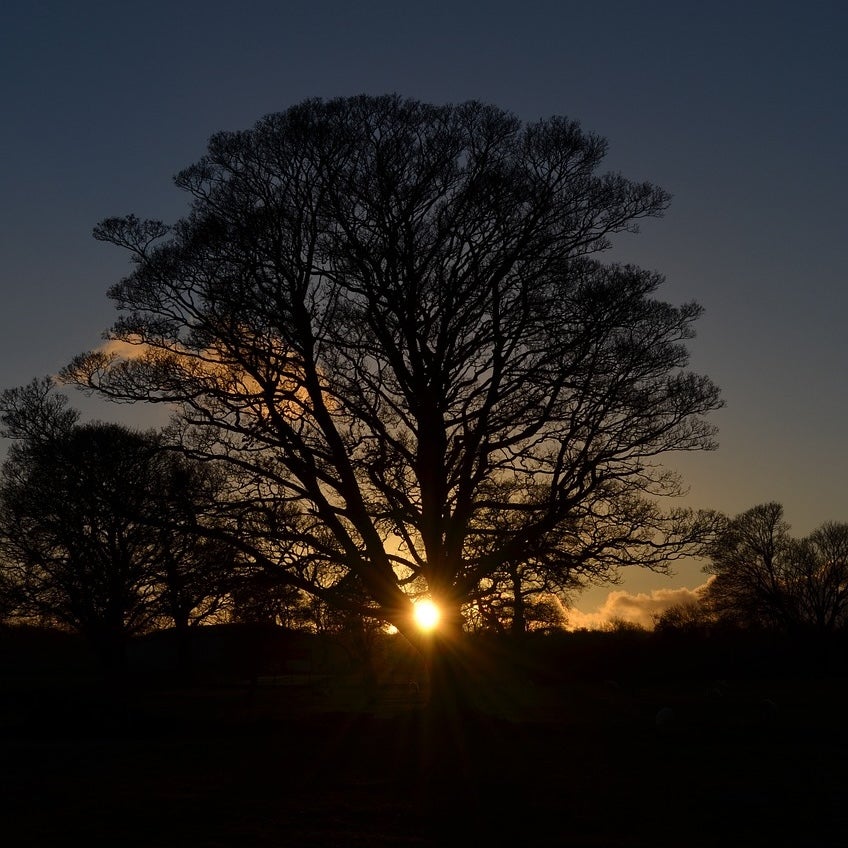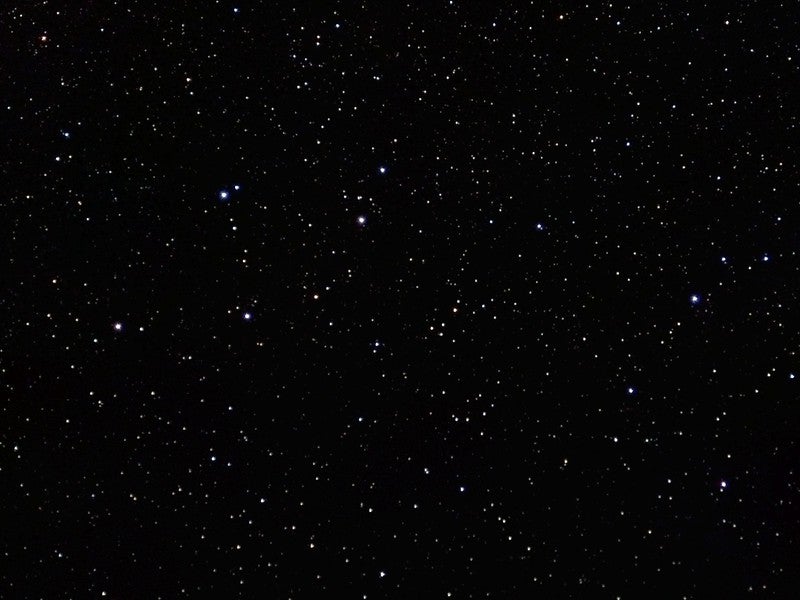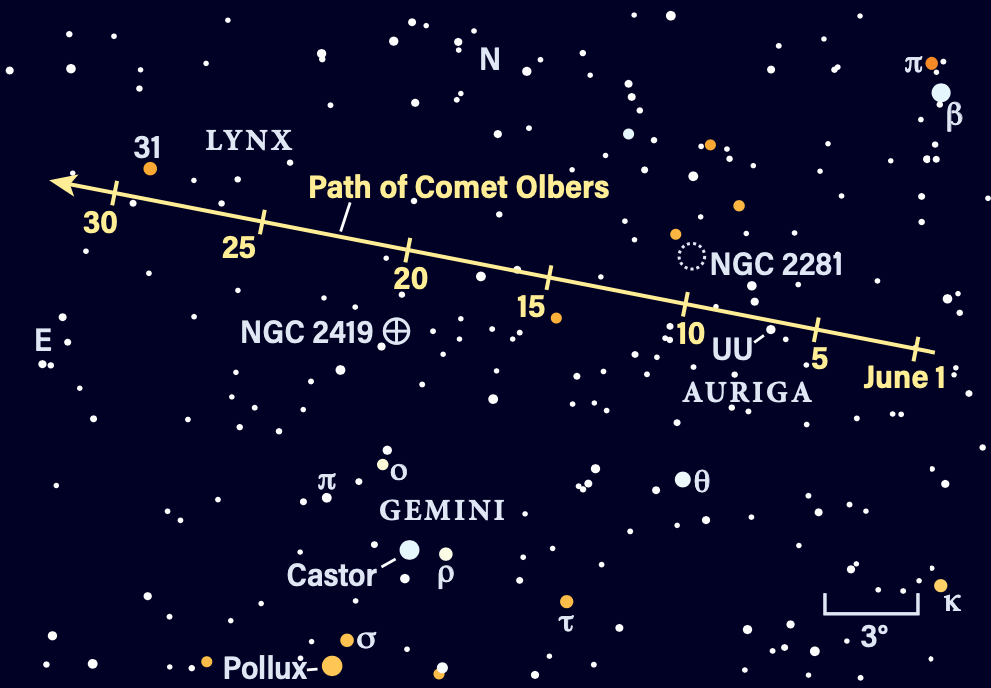
Friday, June 14
First Quarter Moon occurs at 1:18 A.M. EDT this morning. At 9:35 A.M. EDT, the Moon reaches apogee, the farthest point from Earth in its orbit. It will then sit 251,082 miles (404,077 kilometers) away.
By evening, the Moon is setting in the west, standing amid the sparkling stars of Virgo. In just two days’ time, Luna will pass within 2° of the Maiden’s alpha star, magnitude 1 Spica. For now, the Moon floats nearly 20.5° west of this star, about halfway between Gamma (γ) and Beta (β) Virginis. As sunrise reaches halfway across the nearside, the eastern half of the Moon’s face appears lit, including the Sea of Serenity in the lunar northeast.
Turn your telescope toward this broad, dark feature. On the southern rim of this dark, lava-filled “sea” sits the 15-mile-wide (24 km) crater Menelaus. To its northeast is the small, circular pockmark Bessel, which almost appears to sit alone in a vast sea of volcanic plains. Do you see a lighter streak of material that almost appears to bisect the mare, passing up from Menelaus through Bessel and beyond?
It’s tempting to think this ray of thrown-up material is from Menelaus’ impact — but it’s not. This ray actually traces its origin all the way back to the mighty Tycho in the lunar south, which sits just on the terminator separating lunar night from day tonight. Over the next two days, the terminator will move steadily west, better revealing Tycho and its surroundings, including much of the impressive ray system streaking away from this 53-mile-wide (85 km) crater.
Mercury reaches superior conjunction at 1 P.M. EDT. It will soon become visible in the evening sky; we’ll try to catch it later this week, but chances are it won’t be easy to see until next week.
Sunrise: 5:31 A.M.
Sunset: 8:30 P.M.
Moonrise: 1:26 P.M.
Moonset: 1:21 A.M.
Moon Phase: Waxing gibbous (55%)
*Times for sunrise, sunset, moonrise, and moonset are given in local time from 40° N 90° W. The Moon’s illumination is given at 12 P.M. local time from the same location.
Saturday, June 15
Let’s check in on June’s parade of planets in the morning sky. Although Mercury has disappeared, Jupiter is getting easier to spot — an hour before sunrise, the gas giant is 1.5° high and it reaches 6° in altitude 30 minutes before the Sun is due to peek over the eastern horizon. Shining at magnitude –2, it’s an easy naked-eye object even in the brightening sky.
Just under 10° west of Jupiter is Uranus. At magnitude 5.8, you’ll want to nab this one with binoculars or a telescope, and earlier rather than later. An hour before sunrise, it’s nearly 8° high and hangs about 7° to the right of the Pleiades, which are fading in the oncoming dawn.
Next up is magnitude 1 Mars, which lies about 20.5° west of Uranus and to the lower right of the two brighter stars visible in the constellation Aries. Don’t confuse the Red Planet with Saturn, which is the same magnitude but much farther west and higher up in the sky, more than 45° to the upper right of Mars and over 30° high in Aquarius an hour before sunrise.
Between Mars and Saturn is magnitude 7.8 Neptune — again, a binocular or telescopic object. It sits closer to Saturn, some 10.5° east of the ringed world.
Spend some time with each planet, particularly Jupiter, Mars, and Saturn, which all look fantastic through any size scope. Jupiter and Saturn are each attended by several visible moons as well — see how long you can follow them into the growing twilight.
Sunrise: 5:31 A.M.
Sunset: 8:31 P.M.
Moonrise: 2:24 P.M.
Moonset: 1:40 A.M.
Moon Phase: Waxing gibbous (64%)
Sunday, June 16
The Moon passes 1.2° north of Spica at 2 P.M. EDT. From some parts of the Asia, the Moon will appear to pass completely in front of the star in an occultation. The International Occultation Timing Association has more details on the event, including where and when it is visible. Those in North and Central America will be able to catch a similar occultation in about a month’s time, which we’ll highlight in the column then.
As darkness falls this evening across the U.S., you can find the Moon and Spica still within about 4° of each other, with Luna now standing to the right of the bright star. Both remain more than 30° high in the south an hour after sunset.
To their lower right is the lesser-known constellation Corvus the Crow. Corvus’ body is outlined by four bright stars about 17.5° west-southwest of Spica. The bottom two stars in this pattern are Beta and Epsilon (ϵ) Corvi; draw a line between them, then drop about 2° south of the midpoint of this line to land on 6 Corvi, a 6th-magnitude double star whose components are both orange giants. They are separated by 5′, making them easy to discern even in binoculars.
Sunrise: 5:31 A.M.
Sunset: 8:31 P.M.
Moonrise: 3:25 P.M.
Moonset: 2:00 A.M.
Moon Phase: Waxing gibbous (73%)

Monday, June 17
The tiny constellation Delphinus is rising in the east this evening, reaching more than 15° high by about 10:30 P.M. local daylight time.
The Dolphin is nestled beneath Vulpecula and Sagitta, themselves not particularly bright constellations. Instead, use the blazing star Altair in Aquila to point the way — Delphinus lies about 14° to the lower left of this star as these constellations are rising.
Delphinus’ body is marked by a four-star asterism called Job’s Coffin. This diamond shape is anchored by Gamma Delphini at the northeast point; then, moving clockwise, Alpha (α), Beta, and Delta (δ) Del. Note that Gamma is a beautiful binary star, with a 4th- and 5th-magnitude suns separated by about 10″. Small scopes should be able to split them, but binocular users will find the task difficult or likely impossible.
Once you’ve found the Dolphin’s diamond shape in the sky, skim your gaze about 3.5° south-southwest of Beta to land on Epsilon Del. This star marks the tail of our celestial cetacean.
Sunrise: 5:31 A.M.
Sunset: 8:31 P.M.
Moonrise: 4:28 P.M.
Moonset: 2:21 A.M.
Moon Phase: Waxing gibbous (81%)

Tuesday, June 18
Comet 13P/Olbers remains relatively easy to snag in a small scope, passing near the globular cluster NGC 2419 in Lynx tonight.
An hour after sunset, the comet is a bit less than 20° high in the northwest, just inside the boundary of Lynx where it butts up against the domain of Auriga. The comet, which is currently around magnitude 7.2, is a little less than 3° north-northwest of NGC 2419, which glows a fainter magnitude 10.4. Note that while the comet should appear in a small scope, you may need a medium-sized scope to see the 4′-wide globular well.
NGC 2419 itself is quite a unique target. The cluster is one of the farthest-flung globulars belonging to the Milky Way, at a distance of nearly 300,000 light-years from the center of our galaxy. It is sometimes called the Intergalactic Wanderer.
Sunrise: 5:31 A.M.
Sunset: 8:32 P.M.
Moonrise: 5:34 P.M.
Moonset: 2:45 A.M.
Moon Phase: Waxing gibbous (88%)
Wednesday, June 19
Can you see Mercury yet? The solar system’s smallest planet has skipped into the evening sky, but it’s an extremely challenging object — less than 2° high 20 minutes after sunset. Because of its proximity to the Sun, however, it’s a bright magnitude –1.8. See if you can spot it with binoculars or a small scope in the west, though note you’ll need a clear horizon. Getting to an observing location slightly above your surroundings may help. And make sure not to pull out your optics until the Sun has fully disappeared below the horizon.
The small planet will climb quickly, so don’t be discouraged if it’s simply too difficult to find tonight. Within a few more days, it will gain significant altitude as it climbs through Gemini, passing beneath Pollux, one of stars marking the Twins’ heads. An hour after sunset this evening, these two stars should be visible, with Pollux on the left and Castor on the right.
Through your optics, magnitude 1.2 Pollux should glow orangey-yellow, while Castor is blue-white. As a bonus, Castor is a multiple-star system, and even a small scope will split this magnitude 1.6 naked-eye star into two components with magnitudes 1.9 and 3, a few arcseconds apart. But this isn’t all! Some 1.2′ south is a third star in the system, much fainter at magnitude 9.1.
Each of these three stars is itself a binary (though they cannot be optically split), making Castor a six-star system in total.
Sunrise: 5:31 A.M.
Sunset: 8:32 P.M.
Moonrise: 6:41 P.M.
Moonset: 3:15 A.M.
Moon Phase: Waxing gibbous (94%)
Thursday, June 20
The Moon now passes 0.3° north of Antares at 7 A.M. EDT; by evening they are a wide 8.5° apart as our satellite slips rapidly through the sky. See if you can notice Antares’ distinctive red glow — this 1st-magnitude star is an aging red giant whose temperature is cooler than the Sun’s, causing it to glow orangey-red rather than yellow.
Meanwhile, the Moon is now sitting smack dab in the middle of the plane of the Milky Way as it stretches through our sky, not far from the location of Sagittarius A*, our galaxy’s supermassive black hole. That region is located just off the tip of the Sagittarius Teapot asterism, some 4.5° west-northwest of Gamma Sagittarii.
Summer solstice occurs at this afternoon at 4:51 P.M. EDT. During the summer solstice, the Sun reaches its highest point north in for those in the Northern Hemisphere. It is also the longest day and shortest night of the year for that hemisphere. This date also marks the winter solstice in the Southern Hemisphere, conversely bringing the Sun to its farthest point south in the sky.
Related: Will the Sun always shine through Stonehenge on the solstice?
Sunrise: 5:32 A.M.
Sunset: 8:32 P.M.
Moonrise: 7:49 P.M.
Moonset: 3:52 A.M.
Moon Phase: Waxing gibbous (98%)
Friday, June 21
If you’ve got a telescope and an alarm clock, you can catch several of Saturn’s smaller moons congregating near the mighty planet’s rings this morning.
Let’s start about an hour before sunrise on the East Coast, at 4:30 A.M. EDT. At that time, 1st-magntiude Saturn is well-placed above the southeastern horizon, amid the fainter stars of Aquarius.
Tenth-magnitude Tethys sits just off the eastern tip of the rings, while similarly bright Dione lies just south of the rings on the western side of the planet. If you’ve got a large scope or a camera hooked up to your system, you may also capture 13th-magnitude Mimas just northwest of Dione, even closer to the rings’ southern edge to Saturn’s west.
An hour later, as sunrise is breaking in the Eastern time zone, observers farther west will see 10th-magnitude Rhea standing north of the rings off the planet’s eastern limb, with Tethys now closer to the planet, appearing to skim the southern edge of the rings on that side. Dione and Mimas are still south of the rings to Saturn’s west, moving slowly in that same direction.
Another hour later, and those in the Mountain and Pacific time zones may spot — with good seeing and high-quality equipment, perhaps video capture — Tethys’ shadow on the southern polar regions of the planet as the moon prepares to make its own transit, largely visible only from the West Coast. See how long you can follow the dance of these dim moons from whatever location you’re in.
Full Moon occurs at 9:08 P.M. EDT, a little over 24 hours after the summer solstice. We’ll make sure to highlight June’s so-called Strawberry Moon in next week’s column!
Sunrise: 5:32 A.M.
Sunset: 8:32 P.M.
Moonrise: 8:52 P.M.
Moonset: 4:39 A.M.
Moon Phase: Full

Sky This Week is brought to you in part by Celestron.









